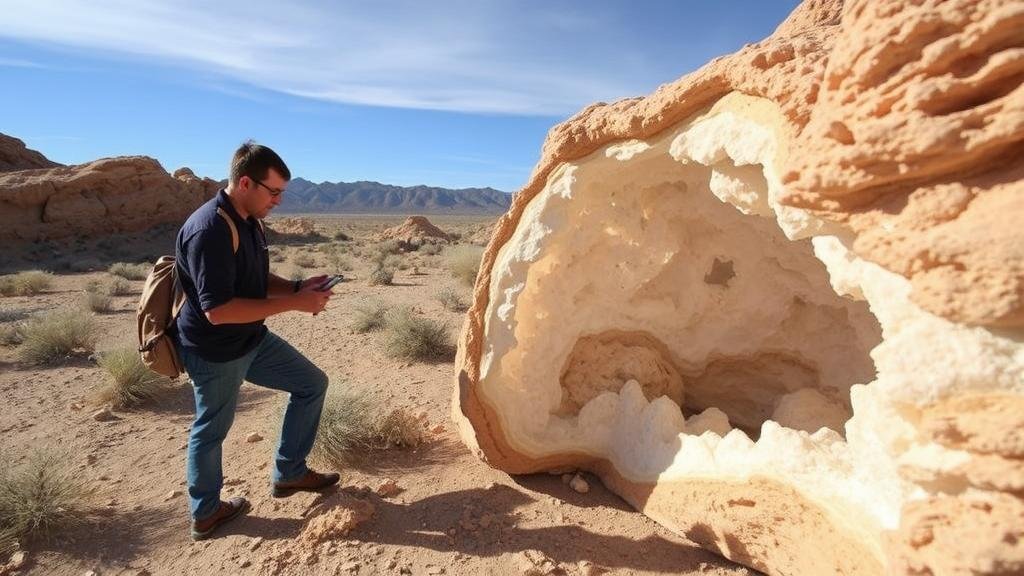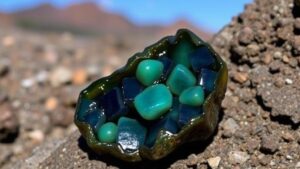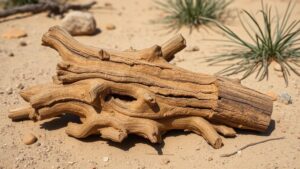Investigating quartz-filled geodes in California’s Mojave Desert, known for their stunning interiors.
Investigating Quartz-Filled Geodes in California’s Mojave Desert
The Mojave Desert, with its arid landscape and striking geological formations, is a treasure trove for rockhounds and mineral collectors. Among its most captivating features are quartz-filled geodes, which are highly sought after for their stunning interiors that emerge from seemingly mundane exterior rocks. In this article, we explore these geological wonders, their formation process, and practical tips for collectors looking to uncover their beauty.
What Are Quartz-Filled Geodes?
Geodes are hollow rock formations that are typically lined with crystals. Quartz-filled geodes, specifically, are characterized by their interior surfaces that are coated with quartz crystals – a mineral composed of silicon dioxide (SiO2). They can vary widely in size, from small marble-sized specimens to massive geodes that can weigh several tons. The average size of a quartz geode ranges from 5 to 12 inches in diameter, but some can exceed 20 inches.
The Formation Process
The formation of quartz-filled geodes is a fascinating process that occurs over thousands to millions of years. Here’s how it typically unfolds:
- Initial cavity creation: Geodes generally begin as bubbles in sedimentary rock, often formed from volcanic activity or through the dissolution of limestone.
- Mineral deposition: Over time, mineral-rich water seeps into these cavities, depositing quartz and other minerals as the water evaporates. This gradual process leads to the crystalline structure typical of quartz geodes.
- Growth of crystals: As conditions continue to favor quartz saturation, the crystals grow inward from the walls of the cavity over extended periods.
Where to Find Quartz-Filled Geodes in the Mojave Desert
The Mojave Desert is renowned for its diverse geological formations and rich mineral deposits, making it a prime location for geode hunting. Some notable areas include:
- Kelso Dunes: Known for its picturesque sand dunes, this area also offers opportunities to find quartz-filled geodes scattered throughout the rocky outcrops.
- Old Woman Mountains: This mountain range is home to numerous geode deposits, providing rockhounds a chance to discover well-formed specimens.
- Rainbow Basin Natural Area: Located near Barstow, this area boasts a variety of geological formations that include potential geode deposits.
Practical Tips for Collectors
For rockhounds eager to hunt for quartz-filled geodes in the Mojave Desert, preparation and knowledge are key to a successful trip. Here are some actionable tips:
- Study the terrain: Familiarize yourself with maps and use satellite imagery to identify rocky areas where geodes might be exposed.
- Bring the right tools: Equip yourself with a rock hammer, safety goggles, and a sturdy backpack to carry your finds. A chiseling kit can also help extract geodes without damaging them.
- Timing is essential: Early morning or late afternoon is the best time for hunting, as the cooler temperatures are more comfortable for exploration and the light enhances visibility.
- Practice sustainable collecting: Only collect what you can responsibly carry and avoid disturbing the environment unnecessarily to preserve the area’s natural beauty.
Cleaning and Displaying Your Finds
Once youve successfully found quartz-filled geodes, the next step is cleaning and displaying them. Here are some guidelines:
- Initial cleaning: Use a soft brush to remove loose dirt and sand. For tougher grime, a solution of water and dish soap can be applied gently.
- Enhancing appearance: If desired, you can polish the exterior with mineral oil, but be cautious to avoid damaging the natural texture of the geode.
- Creative display: Consider using display cases or natural wood stands to showcase the geodes, highlighting their intricate interiors.
Conclusion
Quartz-filled geodes from Californias Mojave Desert not only captivate the eye but also offer a tangible connection to Earth’s geological history. For rockhounds and mineral collectors, the thrill of discovery, coupled with the beauty of these natural creations, makes the Mojave a must-visit destination. With the right preparation and an understanding of the landscape, enthusiasts can enjoy both the challenge of the hunt and the rewards of their spoils.
Remember, the essence of rockhounding lies not just in collecting, but in appreciating the incredible natural processes that create these stunning geological phenomena.



